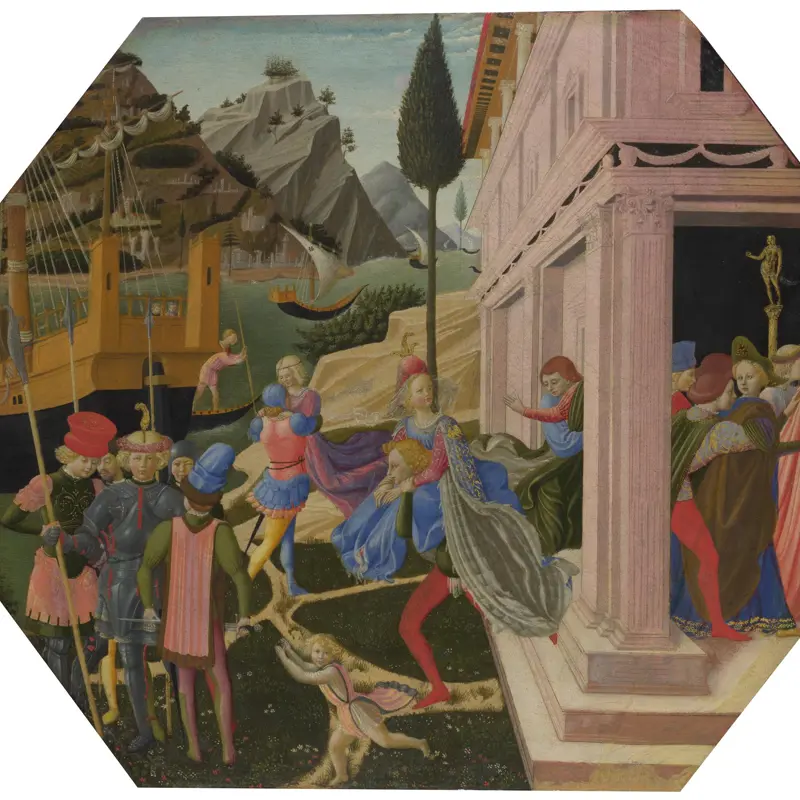Zanobi Strozzi, 'The Annunciation', about 1440-5
About the work
Overview
The Archangel Gabriel has just landed – his gilded peacock-like wings still raised – interrupting the Virgin Mary from her reading. She stares at her visitor in terror and gathers her cloak around her in fear. This is the Annunciation, the moment Gabriel told the Virgin that she would conceive the Son of God. The Holy Ghost who would impregnate her is shown here as a dove, with a gilded halo, flying in above Gabriel’s head.
Strozzi has included Gabriel’s greeting in gold in the border of his pink dress, ‘Ave Maria’ (‘Hail Mary!’). This picture is a variant of paintings of the Annunciation by Strozzi’s teacher, the Florentine painter and friar, Fra Angelico. This panel was cut in half some time before it entered the National Gallery’s collection. The two halves are now reunited but the original picture probably also included a scene showing the expulsion of Adam and Eve from the Garden of Eden, as can be seen in some of Fra Angelico’s versions.
Key facts
Details
- Full title
- The Annunciation
- Artist
- Zanobi Strozzi
- Artist dates
- 1412 - 1468
- Date made
- About 1440-5
- Medium and support
- Egg tempera on wood (probably poplar)
- Dimensions
- 104.5 × 142 cm
- Acquisition credit
- Bought, 1894
- Inventory number
- NG1406
- Location
- Not on display
- Collection
- Main Collection
Provenance
Additional information
Text extracted from the ‘Provenance’ section of the catalogue entry in Dillian Gordon, ‘National Gallery Catalogues: The Fifteenth Century Italian Paintings’, vol. 1, London 2003; for further information, see the full catalogue entry.
Exhibition history
-
2011Devotion by Design: Italian Altarpieces before 1500The National Gallery (London)6 July 2011 - 2 October 2011
Bibliography
-
1550G. Vasari, Le vite de' più eccellenti architetti, pittori, et scultori italiani, Florence 1550
-
1860Christie & Manson, Catalogue of the Very Celebrated & Valuable Series of Capital Pictures, by the Greatest Early Italian Masters: Formed… by… the Late Samuel Woodburn, Esq., London, 9 June 1860
-
1864J.A. Crowe and G.B. Cavalcaselle, A New History of Painting in Italy: From the Second to the Sixteenth Century, 3 vols, London 1864
-
1869Christie's, Catalogue of a Valuable Assemblage of Old Pictures, London, 29 May 1869
-
1878G. Vasari, Le vite de'più eccellenti pittori, scultori ed architettori: Con nuove annotazioni e commenti di Gaetano Milanesi, ed. G. Milanesi, 8 vols, Florence 1878
-
1883Collection Nieuwenhuys', La Chronique des arts, 19, 1887
-
1895London, National Gallery Archive, NG17/5: Annual Report of the Director of the National Gallery to the Treasury for the Year 1894, 1895
-
1903J.A. Crowe and G.B. Cavalcaselle, A History of Painting in Italy, Umbria, Florence and Siena, from the Second to the Sixteenth Century, ed. R.L. Douglas, 2nd edn, 6 vols, London 1903
-
1923R. van Marle, The Development of the Italian Schools of Painting, 19 vols, The Hague 1923
-
1924F. Schottmüller, Fra Angelico da Fiesole, revised edn, Stuttgart 1924
-
1950L. Collobi Ragghianti, 'Domencio di Michelino', Critica d'arte, XXXI, 1950, pp. 363-5
-
1951Davies, Martin, National Gallery Catalogues: The Earlier Italian Schools, London 1951
-
1955J.R. Spencer, 'Spatial Imagery of the Annunciation in Fifteenth-Century Florence', Art Bulletin, XXXVII, 1955, pp. 273-80
-
1955U. Baldini, Mostra delle opere del Beato Angelico nel quinto centenario della morte 1455-1955 (exh. cat. Museo di San Marco, May - September 1955), Florence 1955
-
1958M. Salmi, Il Beato Angelico, Spoleto 1958
-
1961M. Davies, The Earlier Italian Schools, 2nd edn, London 1961
-
1963B. Berenson, Italian Pictures of the Renaissance: A List of the Principal Artists and Their Work, with an Index of Places: Florentine School, 2 vols, New York 1963
-
1964S. Orlandi, Beato Angelico, Florence 1964
-
1974J. Pope-Hennessy, Fra Angelico, 2nd edn, London 1974
-
1976P.J. Cardile, Fra Angelico and His Workshop at San Domenicoin Fiesole (1420-1435): The Development of His Style and the Formation of His Workshop, Phd Thesis, Yale University 1976
-
1976B. Santi, Neri di Bicci. Le Ricordanze, Pisa 1976
-
1976M. Boskovits, Monographien der Abegg-Stiftung Bern, vol. 2, Un'adorazione dei magi e gli inizi dell'Angelico, Bern 1976
-
1980D.C. Ahl, 'Fra Angelico: A New Chronology for the 1420s', Zeitschrift für Kunstgeschichte, XLIII, 1980, pp. 360-81
-
1980A.M. Maetzke, Arte nell'Aretino second mostra di restauri dal 1975 al 1979 (exh. cat. Church of San Francesco, 3 November 1979 - 13 January 1980), Florence 1980
-
1984J. Ruda, 'Style and Patronage in the 1440's: Two Altarpieces of the Coronation of the Virgin by Filippo Lippi', Mitteilungen des Kunsthistorischen Institutes in Florenz, XXVIII/3, 1984, pp. 363-84
-
1985M. Casini Wanrooij and A. Padoa Rizzo, 'Appunti sulla pittura fiorentina del Quattrocento: Benozzo Gozzoli, Domenico di Michelino', Antichità viva, XXIV/5-6, 1985
-
1986Davies, Martin, National Gallery Catalogues: The Earlier Italian Schools, revised edn, London 1986
-
1989P. Joannides, 'Fra Angelico: Two Annunciations', Arte Cristiana, LXXXVII, 1989, pp. 303-5
-
1990G. Didi-Huberman, Fra Angelico: Dissemblance et figuration, Paris 1990
-
1991J. Dunkerton et al., Giotto to Dürer: Early Renaissance Painting in the National Gallery, New Haven 1991
-
1994C.B. Strehlke, 'Fra Angelico studies', in L. Kanter et al., Painting and Illumination in Early Renaissance Florence 1300-1450, New York 1994, pp. 25-43
-
1995R. White and J. Pilc, 'Analyses of Paint Media', National Gallery Technical Bulletin, XVI, 1995, pp. 85-95
-
1998D. Gordon, 'Zanobi Strozzi's "Annunciation" in the National Gallery', The Burlington Magazine, CXL/1145, 1998, pp. 517-24
-
2001
C. Baker and T. Henry, The National Gallery: Complete Illustrated Catalogue, London 2001
-
2003Gordon, Dillian, National Gallery Catalogues: The Fifteenth Century Italian Paintings, 1, London 2003
About this record
If you know more about this work or have spotted an error, please contact us. Please note that exhibition histories are listed from 2009 onwards. Bibliographies may not be complete; more comprehensive information is available in the National Gallery Library.



